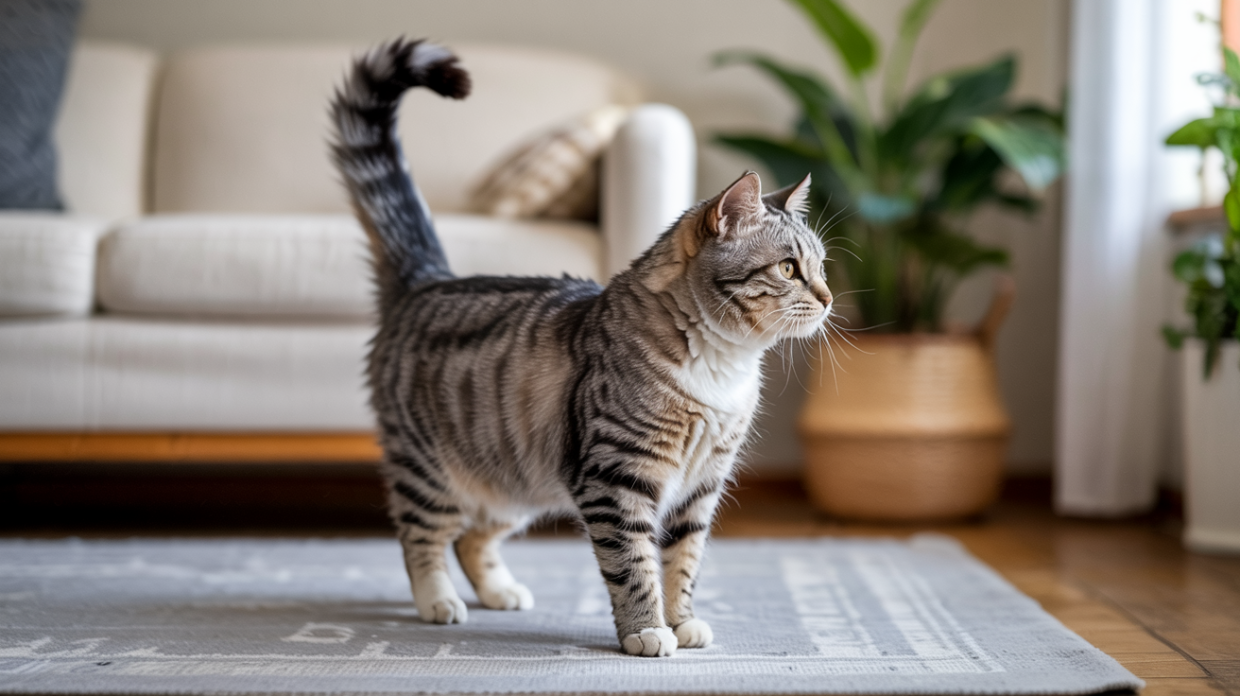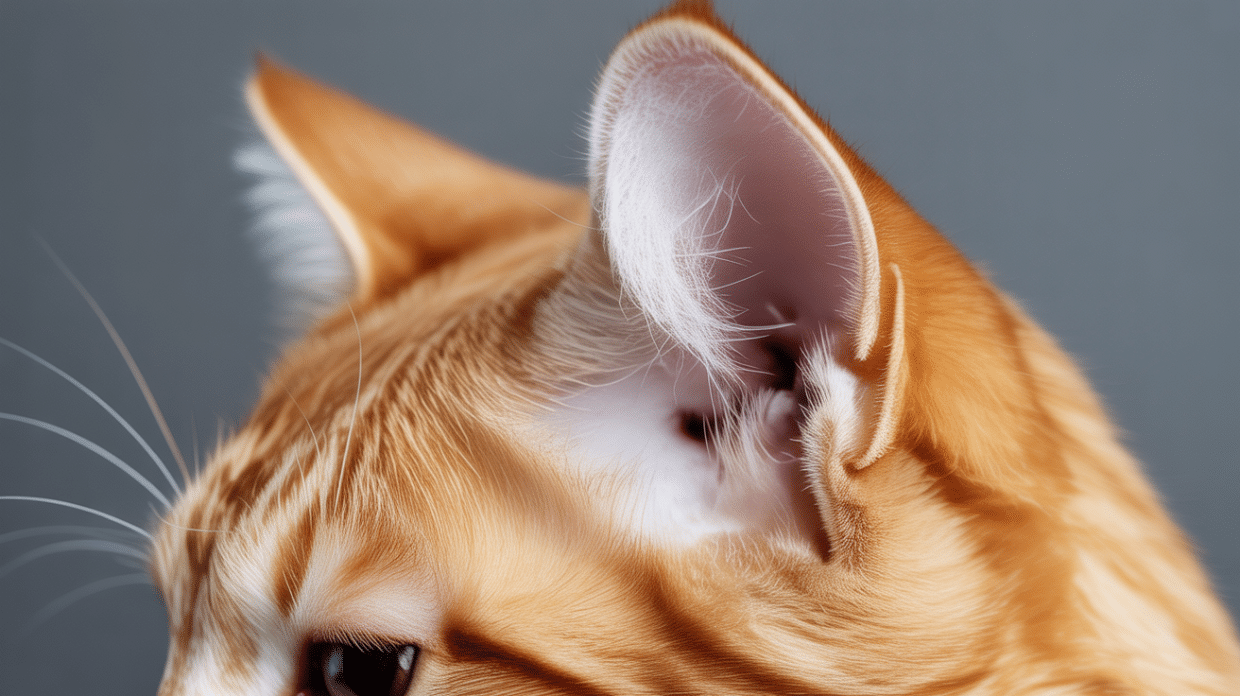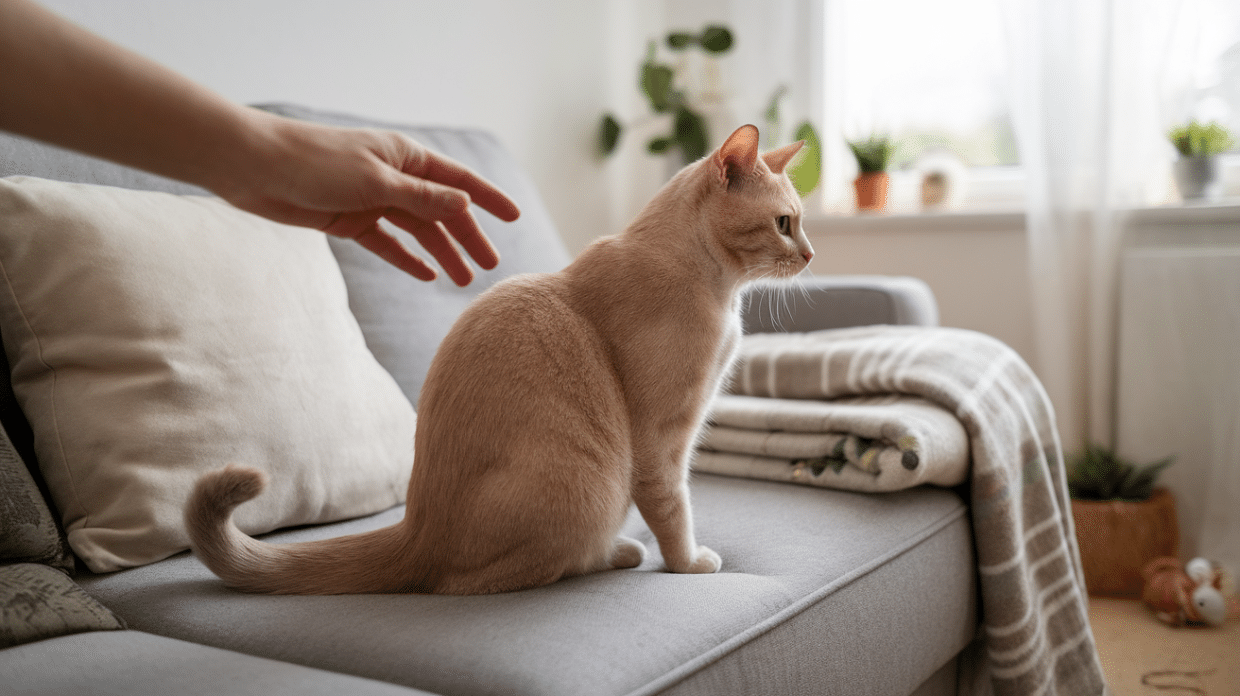Ever noticed how your cat’s tail seems to have a mind of its own? That quick flick when you’re petting them, or the way it stands straight up when they greet you? Your cat’s tail isn’t just a cute accessory; it’s actually talking to you!
Most cat owners overlook these subtle signals, leading to confusion or even scratches when they misinterpret their pet’s mood. Don’t worry, you’re not alone in feeling puzzled by these tail mysteries.
In this guide, I’ll decode what your cat’s tail movements really mean. We’ll explore everything from tail anatomy to those funny little twitches that signal excitement or annoyance.
By the end, you’ll understand your furry friend better and avoid those surprising swats. Ready to become fluent in cat tail language?
The Anatomy of a Cat’s Tail
A cat’s tail is an amazing piece of engineering. It contains 18 to 23 small vertebrae (tiny bones) connected by muscles and ligaments that allow for incredible flexibility.
These bones get smaller as they reach the tip, creating that perfect taper. The whole tail is packed with sensitive nerve endings that help your cat feel every touch.
The tail is really just an extension of your cat’s spine, which explains why cats are so protective of it. If you’re curious about why cats evolved to have long tails in the first place, check out this post on why cats have long tails.
The skin on the tail is looser than on other body parts, providing cats with some protection if their tail gets caught, a smart adaptation from their wild ancestors.
Some cats, like the Manx, are born with very short tails or no tails at all due to genetic mutations. These cats adapt by developing stronger back legs and relying more on their inner ear for balance.
How Cats Use Their Tails for Balance
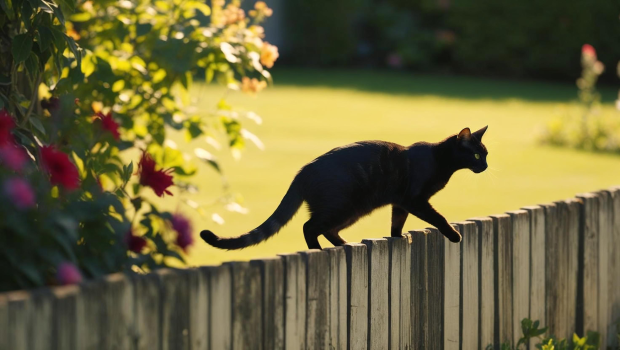
In the Himalayas, people often hike up tough trails with cameras, not to climb Mount Everest, but to spot one of the rarest cats in the world, the snow leopard.
These cats live high up in the mountains and are called “ghosts” because they move so silently and skillfully. How do they walk across cliffs and snowy ledges without falling?
One of their biggest secrets is their tail. Their long, thick tail acts like a counterbalance, helping them stay steady even in the most dangerous places.
Just like snow leopards, your cat at home depends on their tail to stay balanced, too. During quick movements, the tail becomes even more important.
When your cat zooms around a corner, their tail swings to the outside of the turn, preventing them from tipping over.
It’s an automatic stabilizer that works without conscious thought. Even falling involves the tail.
Though cats primarily use their flexible spine and inner ear for the famous “righting reflex,” the tail adds crucial steering control.
It helps them twist mid-air to land safely on their feet, even from surprising heights.
Next time your cat walks along your bookshelf, watch their tail’s subtle movements; you’re seeing a natural acrobat at work!
Reading Your Cat’s Tail Language
Your cat’s tail is constantly telling you how they feel.
A high, upright tail (especially with a quivering tip) means your cat is confident and happy to see you.
A question-mark shape signals playfulness and friendliness, while low or tucked tails indicate fear or submission.
Gentle tip twitches show curiosity, but fast side-to-side swishes warn of irritation.
A puffed-up “bottle brush” tail means your cat feels threatened. Unlike dogs, a wagging cat tail usually signals frustration, not happiness!
Why Cats Don’t Like Their Tails Touched
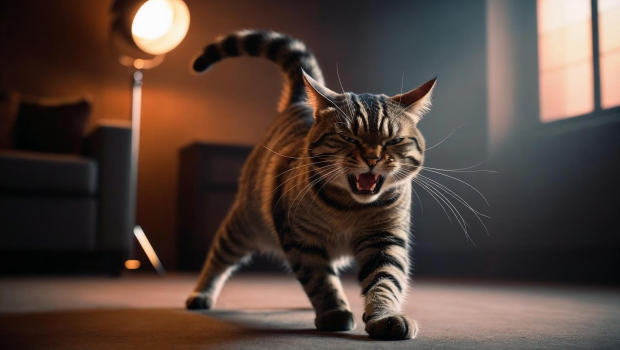
Most cats get annoyed when you touch their tails, and for good reason. The tail contains a high concentration of nerve endings, making it extremely sensitive to touch.
What feels like a gentle stroke to you might feel overwhelming to your cat, similar to someone tickling you when you’re not in the mood.
Cats also instinctively protect their tails because they’re vulnerable. In the wild, a damaged tail affects balance and hunting abilities, so this protective response is deeply ingrained.
If your cat ever experiences even a minor tail injury, they’ll be extra cautious about letting anyone near it again.
There are exceptions, though. Some cats enjoy gentle petting at the base of their tail where special nerve bundles can create pleasant sensations.
Always let your cat guide you – if they push that spot toward you, they’re asking for more! But even these cats usually prefer you avoid touching the length of their tail.
Common Cat Tail Injuries and What to Watch For
Cat tails are vulnerable to various injuries that can affect your pet’s health and mobility. Here’s what to watch for:
Broken Tails
A broken tail may exhibit unusual drooping, swelling, or your cat holding it at an odd angle. Sometimes the break is obvious, but often it’s subtle and only noticeable by changes in how your cat carries their tail.
These injuries typically happen from falls, getting caught in doors, or accidents. In some cases, your cat might also show signs of pain when touched near the tail or may avoid movement altogether.
If you notice any of these symptoms, it’s important to consult a vet promptly to prevent further complications and ensure proper healing.
Nerve Damage
If nerves in the tail are injured, your cat might lose control over it, resulting in a limp tail that drags behind them like a lifeless rope. This can be especially concerning to watch as a pet owner.
Nerve damage varies in severity – some cats recover partial or full function over time, while others experience permanent paralysis of the tail.
The damage typically occurs when the tail is pulled forcefully, such as when it is caught in a closing door or grabbed by another animal or a small child.
Infections
Scratches, bites, or other wounds can lead to infections in the tail that shouldn’t be ignored. These infections often start small but can quickly become serious.
Look for obvious signs, such as swelling, redness, hair loss, or your cat excessively licking their tail. You may notice that your normally affectionate cat becomes irritable when you approach their tail area.
As infections progress, you may detect an unpleasant odor or see discharge from the affected area.
The skin might feel hot to the touch, and scabs or crusty areas could form. In longer-haired cats, infections can be hiding under all that fluff, so regular, gentle examination is important.
Warning Signs
Certain tail symptoms should trigger an immediate vet visit. If your cat’s tail suddenly droops when it was normal before, shows signs of pain when touched, or if your cat hisses and won’t let you near it, don’t delay seeking professional help.
A cat that suddenly starts biting at its tail or chasing it obsessively may be responding to pain or neurological issues.
Changes in bathroom habits following a tail injury can indicate serious complications. The nerves controlling a cat’s bladder and bowels run through the tail area so that severe injuries can affect these functions.
The Development of a Kitten’s Tail
Just like babies learning to walk, kittens must learn to control their tails. When they are first born, their tails are short and stubby, with limited mobility.
As they grow, so do their tails, and they gradually develop the muscle control needed for those precise tail movements adult cats make look so effortless.
Around 3 to 4 weeks of age, kittens start experimenting with their tails to maintain balance. It’s absolutely adorable to watch them wobble and sometimes fall as they figure out this new appendage.
Their attempts at coordination often lead to comical situations, they might chase their tails or seem surprised when their tail move!
By eight weeks, most kittens have developed decent tail control, although they’ll continue to refine these movements for several more months.
Only mature cats demonstrate the complete mastery that enables the impressive acrobatic feats and subtle communication signals we associate with adult felines.
Tails and Cat Breeds: Interesting Variations
Cat breeds show fascinating tail diversity. The Manx and Japanese Bobtail cats have naturally short or absent tails due to genetic mutations.
Rather than being handicapped, they’ve adapted with stronger hind legs and different balancing techniques that make them just as agile as their long-tailed cousins.
Maine Coons boast spectacular tails that can reach 16 inches long! These bushy tails serve multiple purposes, not just for balance but also as built-in blankets during cold New England winters. They often wrap these magnificent tails around themselves while sleeping.
Siamese cats are renowned for their distinctive, long, thin, and whip-like tails, which perfectly complement their sleek bodies. They use these tails with incredible precision, both for balance and expressive communication.
The American Ringtail can curl its tail in a complete ring over its back – a unique trait that started as a mutation but became a defining characteristic of this rare breed.
Fun Facts About Cat Tails
Did you know house cats and wild cats hold their tails differently? Your pet cat walks with its tail upright to show friendliness – a behavior that developed through domestication.
Here are some other interesting facts:
- Wild cats keep their tails low for stealth. That upright tail is essentially your cat saying, “I’m domesticated and I trust humans!”
- A cat “tail hug” is one of the sweetest gestures your pet can offer. If your cat wraps their tail around your arm or leg, take it as a huge compliment – it’s like holding hands in cat language.
- In Japanese folklore, cats with exceptionally long tails were believed to possess magical powers.
- Cats can rotate their ears 180 degrees using 32 muscles to pinpoint sounds with incredible precision.
- Whiskers are super sensitive; they’re deeply embedded and help cats detect tiny changes in air currents, aiding navigation in the dark.
- Some cats are “left-pawed” or “right-pawed”. Just like humans, cats often favor one paw over the other when playing or reaching.
How to Respond to Your Cat’s Tail Signals
Understanding tail language is just half the battle – how you respond matters too. The golden rule? Respect what your cat is telling you. If their tail is thrashing or puffed up, they need space.
Pay attention to tail position: a high, relaxed tail welcomes interaction, while a low or tucked tail signals vulnerability.
Create safe spaces where your cat can retreat when feeling threatened. Be consistent in your responses so your cat learns to trust you.
Watch for changes in normal tail behavior, as this might indicate pain or illness.
Grooming Your Cat’s Tail
Most cats keep themselves clean, but their tails occasionally require assistance. Long-haired cats, in particular, require regular brushing to prevent mats and tangles.
Focus on the underside of the tail where knots commonly form. Use gentle strokes from base to tip with a soft brush. Making this routine from kittenhood helps cats accept it as normal.
Elderly or overweight cats may struggle to reach all parts of their tail, resulting in dirty or greasy fur. If you notice this, use a slightly damp cloth for gentle wiping.
Regularly check the base of the tail for fleas and flea dirt (tiny black specks that turn reddish when wet). This area is a favorite hiding spot for parasites since cats can’t easily reach it to scratch or bite.
Never cut mats out yourself, as the skin can pull up into the mat, making it impossible to tell where fur ends and skin begins.
Tail Health Across a Cat’s Lifespan
Your cat’s relationship with its tail changes as it ages. Kittens start with minimal tail control – their movements are clumsy and unpredictable as they learn this new skill.
The tail may seem disproportionate to their body, but coordination develops gradually through play and practice.
Adult cats demonstrate peak tail mastery. Their tail movements become precise and meaningful. Its a reliable mood indicator and balancing tool.
They’ve learned exactly how to use this appendage for maximum effect, whether jumping between furniture or communicating their feelings.
Senior cats often show subtle changes in tail carriage and movement. Arthritis can develop in the tail joints, causing them to hold their tails lower or move them less frequently. You might notice decreased mobility or stiffness.
A slightly lower tail in an older cat doesn’t necessarily signal unhappiness – it’s often just a normal aging change, like gray hair in humans.
However, sudden changes should always prompt a vet visit.
Conclusion
Your cat’s tail isn’t just cute, it’s a powerful tool for balance, mood, and communication. By learning what tail positions and movements mean, you’ve unlocked a new way to understand your feline.
A tail held high says they’re happy to see you. Rapid swishing during petting? That’s your cue to give them space. Every cat has their own version of tail talk, so pay close attention.
The more you observe, the better you’ll understand your cat’s signals. This insight strengthens your bond and builds trust. Watch that tail—it’s saying more than you think!
Frequently Asked Questions
Can Cats Live Without Tails?
Yes! Breeds like the Manx live perfectly happy lives without tails. They compensate with stronger hind legs and rely more on their inner ear for balance. Watch a Manx cat jump or run, and you’ll see they’re just as agile as tailed cats.
What Does it Mean When My Cat Wraps its Tail Around Me?
This is essentially a cat hug! When your cat wraps their tail around your arm or leg, they’re showing affection and trust. It’s one of their most endearing expressions of love.
Why Does My Cat Flick its Tail When Lying Down?
That subtle flicking while your cat is lounging means they’re alert despite appearing relaxed. They’re processing their surroundings while resting.

